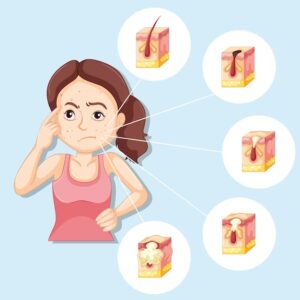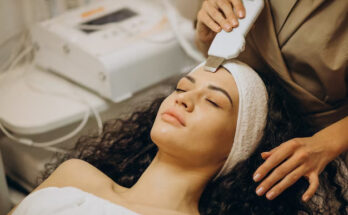More isn’t necessarily better when it comes to skin care, as skin cycling demonstrates. Learn how this method of skin care functions and whether dermatologists endorse it.
Skin Cycling: What Is It?
Skin cycling is a skin-care regimen that includes “rest days” each week so that your skin can recover from utilizing particular products. According to Wattenberg, doing so can aid in reducing irritation and inflammation.
- In order to begin skin cycling, you will need:
- Glycolic acid or salicylic acid, for example, is an exfoliant.
- a retinoid, such as retinaldehyde or retinol
A moisturizer (the American Academy of Dermatology, or AAD, advises using a fragrance-free ointment or cream)
It just comes down to time once those components are at hand. The first night of the four-night cycle is an exfoliation night, the second is a retinoid night, the third and fourth are recuperation nights, and the cycle is repeated the following day, according to Bowe. Depending on how your skin reacts, your dermatologist may advise modifying the procedure.
Procedure for Skin Cycling
Here is a step-by-step guide:
Night 1: Exfoliation occurs on .
The AAD recommends cleansing, patting your skin dry, and then exfoliating to remove the dead skin cells from the top layer of your skin. This procedure should come first for a good reason: “Your other products will perform more effectively because they are able to penetrate more deeply into the skin in a controlled, predictable way,” claims Bowe. After that, you should moisturize. But first, a word of caution: While some claim that exfoliating enhances the appearance of their skin, the AAD cautions that it can also cause redness and irritation if done wrong, such as by doing it too regularly. Another suggestion is that Bowe likes chemical exfoliants over physical scrubs since they are gentler.
Night 2: Retinoids
Retinoids, which are vitamin A derivatives that can help lessen the appearance of fine lines and wrinkles, are the topic of this evening, according to Harvard Health Publishing. These include milder over-the-counter treatments like retinol and prescription drugs like tretinoin. One of the potent chemicals to add in your skin-cycling program, according to Bowe, is retinoids. However, there is a warning attached to them: “They can be very irritating when you first introduce them, or if you have sensitive, reactive skin,” she continues. Make sure to wipe up and pat yourself dry before applying. If you’re particularly sensitive to retinoids, it’s a good idea to moisturize the area beforehand, especially around delicate spots like the corners of your nose and beneath your eyes.
Nights 3 and 4: Restorative
The third step is the recovery time, which is usually nights three and four. Think about hydration and moisture, avoid any ingredients that can irritate your skin, and concentrate on nourishing your skin bacteria and rebuilding your skin barrier. Cleanse your face well before using a moisturizer, and Bowe advises against patting your skin completely dry on these nights. She continues, “You can also use a hydrating serum before your moisturizer.”
In real life, the timing of your cycles can vary depending on your skin type, and your dermatologist can advise further personalization. You can increase your recovery evenings if you’re feeling sensitive and irritated, advises Bowe.
Regarding Frequency
In terms of how long you should keep doing it, Bowe says you can repeat and alter your skin-cycle routine over time. Depending on how your skin reacts to the “active” chemicals you are applying, it might be a reset or it can be used continuously, says Wattenberg.
.
One smart maxim is that consistency over frequency is key when it comes to your routine, whether you’re skin cycling or not. Even if you don’t use a product every day, it will be far more effective if you use it frequently.
What Are the Skin Benefits of Skin Cycling?
Dermatologists and fans of skin cycling claim a number of advantages to the technique, some of which are listed below.
.
Skin Cycling Can Aid with Skin Barrier Repair
Not just from an aesthetic but also from a health perspective, a good skin barrier is crucial. The skin barrier shields you from allergens, harsh chemicals, and infections, according to a review that appeared in the Indian Journal of Medical Research in January 2018. In fact, research indicates that symptoms of a number of skin diseases, including acne, eczema, and atopic dermatitis, may be related to a damaged skin barrier.
Over-exfoliation and the use of potent retinoids can damage this barrier (causing redness and irritation), however rest days are helpful in these situations. For many of Bowe’s patients, recovery nights—which concentrate on feeding the skin barrier—have changed everything.
Skin cycling may lessen the negative side effects of a product.
The goal of skin cycling, according to Wattenberg, is to lessen the negative effects of many active components. The fewer frequently a product is used, the lower the risk of side effects. To help prevent irritation, she advises using retinol in between two layers of moisturizer.
Skin Cycling Can Help Prevent Seasonal Skin Problems
In order to assist your skin cope with the weather better, skin cycling may help keep it from drying out in the first place.
Possible Skin Cycling Side Effects
Because rest days give your skin a chance to recover itself, skin cycling can help reduce the potential negative effects of substances like retinoids and exfoliants, according to Wattenberg.
However, you might have some adverse effects when you first start using a retinoid if you aren’t already. “Retin-A and retinol are two common ingredients that cause dryness, irritation, and even inflammation when you begin using them,” claims Wattenberg. Retinol may increase your susceptibility to sunburn, according to the Cleveland Clinic, making sunscreen even more important than usual. When your skin becomes used to the substance, these negative effects typically disappear.
Bowe advises using moisturizer first on those with sensitive skin to protect against the potential effects of retinoids, especially on delicate areas like the area around the eyes and the corners of the mouth, nose, and neck. She suggests switching up the sequence and putting the moisturizer last after your skin has gotten acclimated to the retinoid. Applying a moisturizing, barrier-repairing cream that doesn’t irritate the skin or penetrate the retinoid too deeply to cause unneeded irritation is a good idea, according to Bowe.
Skin cycling: What Do Dermatologists Think?
The response to skin cycling has been very good for Bowe. “I’ve had so many people reach out to me to tell me that this is the first time they feel like they understand how their skin care is working to benefit their skin as part of a bigger picture,” says Bowe.
Skin cycling might not be the best option for those seeking significant outcomes, though. You may think of skin cycling as your warm-up routine because much of the data we have on the efficiency of these types of substances is based on daily application, according to Dr. Zeichner.
Nevertheless, products work far better when used consistently (for instance, in a cycle) than when used irregularly.
Bowe admits that skin cycling won’t provide many extra advantages if patients can get their skin used to a steady and potent retinoid (and don’t have irritation, blotchy patches, or sensitivity). She claims that the problem is that many people can’t even reach to that stage. “Most people find it impossible to use a powerful, stable retinoid every night without experiencing dryness, irritation, and discomfort,” adds Bowe, especially those with dry skin or sensitive skin.
The goal of skin cycling, according to her, is to get the most out of your skin-care regimen while reducing any irritation that may result from overusing potent treatments like retinol or exfoliating acids.
Who Should Try the Skin Cycling Trend (and Who Should Avoid It)?
Skin cycling might be something to think about if you’re trying to incorporate retinol, an exfoliation, or another potentially irritating product into your cosmetic routine, advises Wattenberg.
Another group that it might profit?Skin sensitivity sufferers, according to Zeichner. Bowe advises speaking with your dermatologist to customize your skin-cycling program if you have a skin condition like acne or rosacea, especially if you’re taking a prescription medication for your skin.
Additionally, as was already mentioned, skin cycling might not be as beneficial for you if you currently use a retinoid every night and find that your skin tolerates it well. Bowe exclaims, “For those true exceptions who really can handle a powerful retinoid every night, power to you!” Some people may not be able to advance past intermittent use, so you need to tailor your regimen to your personal skin needs,” Zeichner continues.
For someone who currently uses an exfoliating product daily without suffering irritation (which may be the case for someone with oily or acne-prone skin, according to Bowe), the normal skin-cycling regimen may not be the best option. She recommends modifying the skin-cycling regimen in this instance to include a salicylic acid toner every morning and a stronger combination of exfoliating acids on exfoliation days.
Unsure if a skin-cycling regimen is the best choice for you? Ask your dermatologist for advice on the best course of action if you’re unsure.
Conclusion Regarding Skin Cycling
Skin cycling is not a novel idea. The fact that skin cycling is so well-liked now is due to consumers realizing that using more products doesn’t always result in better or healthier skin. This is a less-is-more strategy that works and provides you with a timetable that is well-structured and makes sense, according to Bowe.



